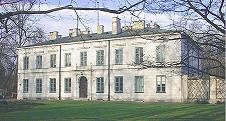Natolin, jego przeszłość, rewaloryzacja i rozbudowa
Natolin, its Past, Revalorisation and Expansion
Author(s): Wojciech FijałkowskiSubject(s): Fine Arts / Performing Arts
Published by: Krajowy Ośrodek Badań i Dokumentacji Zabytków
Keywords: palace–park complex; Natolin; Warsaw; Jan III Sobieski; August II the Strong; Adam Czartoryski; Versailles; Empire–style; landscape park
Summary/Abstract: The Romantic palace–park complex in Natolin, situated in the southern part of Warsaw, emerged in place of the royal zoological garden of Jan III Sobieski, which dated back to the last quarter of the seventeenth century. In 1730, King August II the Strong founded on this site a Pheasantry and created a radial configuration of roads, modelled on the Versailles premise. In 1780–1782, Prince Adam Czartoryski built, in accordance with projects by Szymon Bogumił Zug, a Classicistic palace with a semi–open vista salon to the side of the Vistula escarpment. The interior of the palace was embellished by the paintings of Vincenzo Brenna. During the first quarter of the nineteenth century, the palace was redesigned by Christian Piotr Aigner, who adapted it for the purposes of a summer residence of the Potocki family, decorated by Empire stucco ornaments. At the same time, the Pheasantry became known as Natolin, from the name of Natalia, daughter of Count Potocki. The reconstruction of the palace was accompanied by the erection of an outbuilding, a stable and carriage house, Empire–style cottages of the caretakers, and a Gothic–Classicistic Dutch dairy. The former zoo was transformed into an English landscape park. In 1834–1835, additions to the park included a Moorish bridge designed by Henryk Marconi, a statue of Natalia Potocka–Sanguszkowa, a Doric temple, a Roman aqueduct and a Moorish gate. The end of the nineteenth century marked a partial degradation of the historical complex, intensified by damage incurred during the second world war. Following the nationalisation of Natolin in 1945, the complex became the residence of the President of the Republic of Poland and, subsequently, the seat of the Council of Ministers. Since 1993 it houses the College of Europe. The intention of currently conducted conservation is to restore the palace–park complex to its former splendour and adapt a number of buildings for the needs of the College.
Journal: Ochrona Zabytków
- Issue Year: 1999
- Issue No: 1
- Page Range: 1-9
- Page Count: 9
- Language: Polish

